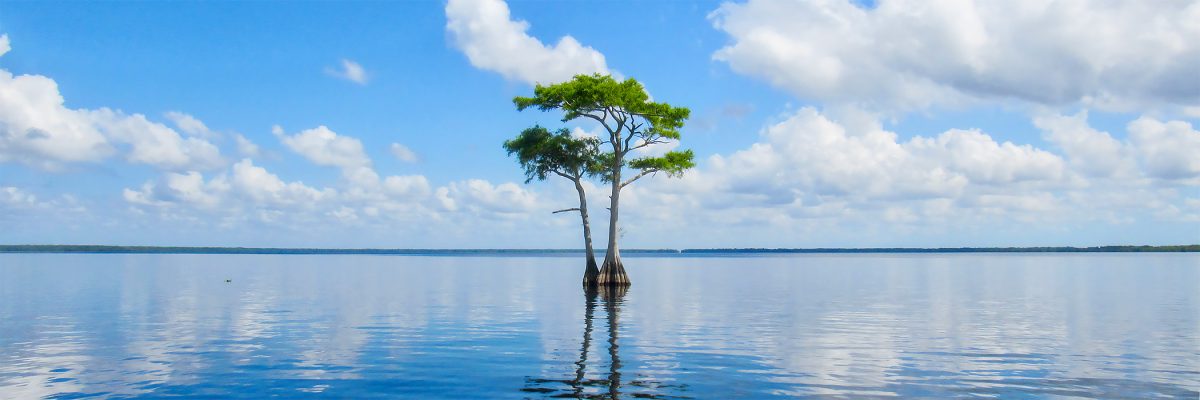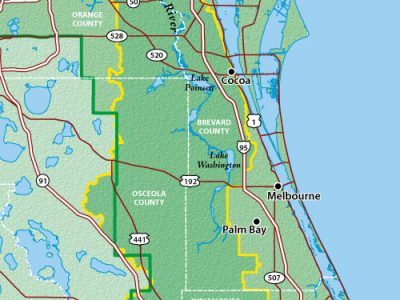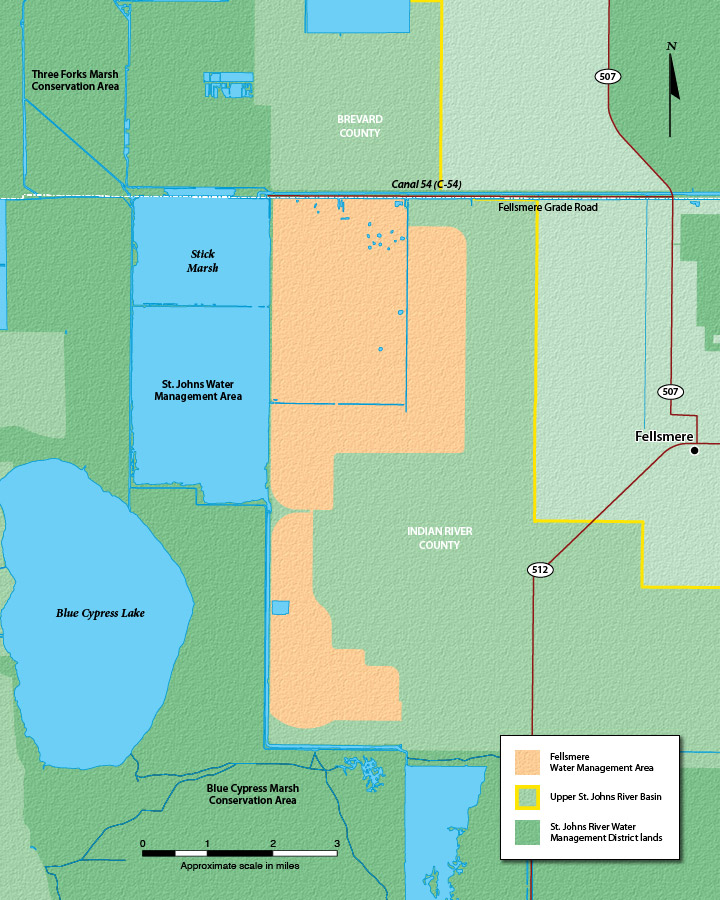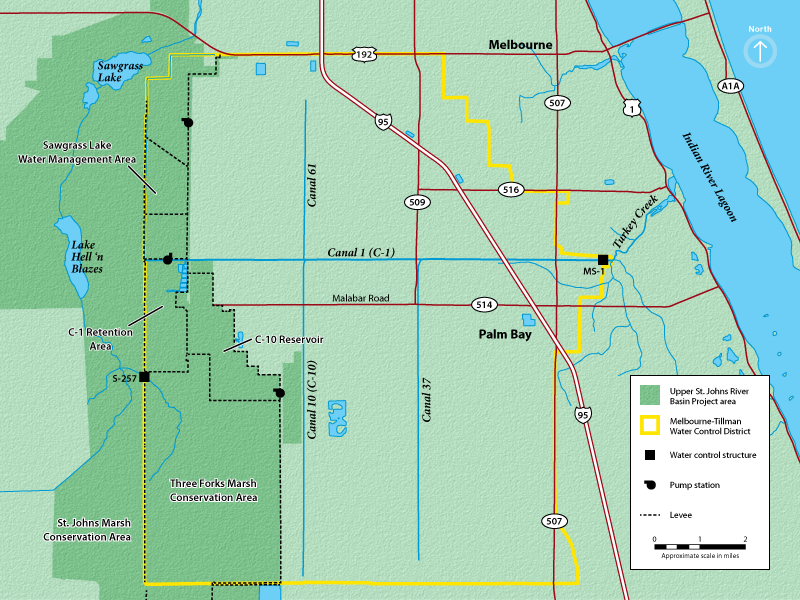Watch a flight over the upper St. Johns River
Florida’s longest river begins its 310-mile northerly journey to the Atlantic Ocean from a drainage basin west of Vero Beach in Indian River County. The 2,000-square-mile basin — the headwaters of the St. Johns River — is perhaps the most distinctive portion of river. Known as the Upper St. Johns River Basin, the area features a mosaic of marsh, sawgrass and cypress domes, and is visually similar to the Florida Everglades.
The basin extends from the headwaters of the St. Johns River in Indian River and Brevard counties to the confluence of the St. Johns and Econlockhatchee rivers in Seminole County, and originally contained more than 400,000 acres of floodplain marsh.
In the early 1900s, the upper basin was diked and drained for agricultural purposes. By the early 1970s, 62 percent of the marsh was gone. Canals were constructed to divert floodwaters from the basin east to the Indian River Lagoon. The alterations diminished water quality in the lagoon and degraded the upper basin’s remaining marshes.
In 1977, the St. Johns River Water Management District and the U.S. Army Corps of Engineers (USACE) embarked on an ambitious, long-term flood control project that would revitalize the upper basin. The Upper St. Johns River Basin Project reclaimed drained marshlands by creating reservoirs and replumbing existing canals. The goals were numerous: to improve water quality, reduce freshwater discharges to the Indian River Lagoon, provide for water supply, and restore or enhance wetland habitat.
The success of the restoration has been lauded over the years. An Australian river advocacy organization awarded the International Thiess River Prize to the District in October 2008 in recognition of the upper basin project. The award recognized the project as a modern model of floodplain management, balancing the needs of the river with people’s needs. Also, in August 2016, the Florida Engineering Society highlighted the project as a “Project of the Century,” presenting project engineers with an excellence in engineering award.
In May 2016, the District and USACE celebrated the completion of the upper basin project, one of the largest and most ambitious flood control and wetland restoration projects in the world. The project has now moved into long-term maintenance.
The upper basin project is a semi-structural system of four water management areas, four marsh conservation areas and two marsh restoration areas covering approximately 166,500 acres in Indian River and Brevard counties.
Throughout the project area, water control structures and new construction have been kept to a minimum. Dikes have been fortified and agricultural drainage routes have been re-directed to improve water quality and enhance the marsh system. The result is a flood protection strategy that relies on a more natural approach. Under maximum storm conditions, the project is designed to hold 500,000 acre-feet of water — enough water to cover the 200,000-acre project with an average of 2.5 feet of water. More information is available in the Surface Water Improvement and Management Plan (SWIM) for the basin.
The upper basin project has given new life to the river’s headwaters. The design of the project is on the cutting edge of environmental restoration technology and demonstrates a new level of compatibility between flood control and environmental protection.
Upper St. Johns River Basin map
Honors recognize District’s work
2008: Thiess Riverprize
Australian-based Riverfoundation gave international recognition of the Upper St. Johns River Basin Project as one of the most innovative environmental river restoration projects in the world. The organization’s mission is to build a global community of river leaders to champion the health and resilience of river around the world.
2016: Project of the Century by the Florida Engineering Society
The project was recognized for excellence in engineering. The society supports engineering education, advocates licensure, and promotes ethical and competent practice of engineering.
2019: Association of State Wetland Managers
The nonprofit group featured the project as one of the nation’s top wetland restoration projects. The association promotes and enhances protection and management of wetlands and promotes application of sound science to wetland management efforts.
History of the Upper St. Johns River Basin and the upper basin project
The Upper St. Johns River Basin once contained more than 400,000 acres of fertile marsh. Agricultural interests saw the value of the rich peat soils beneath the water and drained thousands of acres of the river’s headwaters to create farmlands.
Devastating hurricanes in the 1920s and 1940s demonstrated the need for improved flood protection for the region. In response to flooding problems, the U.S. Army Corps of Engineers (USACE) began planning a flood control project in the basin in the 1950s. The original upper basin project involved a series of flood storage reservoirs west of the St. Johns River, in Osceola and Orange counties. The project also included a network of canals to divert excess floodwaters from the upper St. Johns to the Indian River Lagoon. The largest of these canals is known as Canal 54 (C-54).
Portions of this flood control project, including C-54, were constructed by 1973. C-54 was originally designed to divert up to 6,000 cubic feet per second of water from the St. Johns River to the Indian River. Environmental studies found that this diversion of freshwater would significantly reduce the population of shellfish in the Indian River, harming the commercial shell fishing industry. In addition, the large volume of freshwater diversion would cause big swings in the salinity of the lagoon, impacting fish and wildlife resources. The loss of freshwater in the St. Johns River was found to adversely impact wildlife and threatened the use of the river for public water supply. Construction of the federal flood control project was halted in 1973 by President Richard Nixon.
The St. Johns River Water Management District took over the project in 1977 and worked with USACE to design and build what is today’s Upper St. Johns River Basin Project. The project mimics nature by storing water in restored marshes rather than move it eastward through the C-54 to the lagoon.
The completed project includes four water management areas, four marsh conservation areas and two marsh restoration areas covering approximately 166,500 acres in Indian River and Brevard counties.
Water management areas
The water management areas are large manmade water bodies that capture runoff from citrus groves and livestock pastures. This runoff water is reused for farm irrigation and freeze protection. Perhaps the best known water management area is the St. Johns Water Management Area, known by anglers as the Stick Marsh/Farm 13. The others are the Blue Cypress, Fellsmere and Sawgrass Lake water management areas.
Marsh conservation areas
The conservation areas are the historic, unaltered marshes that follow the river valley, including some former agricultural lands restored to marsh. Blue Cypress Marsh Conservation Area resembles the original marshes of the upper basin. Marsh conservation areas improve the river’s hydrology and downstream flows. The other marsh conservation areas are Three Forks Marsh, Fort Drum Marsh and St. Johns Marsh conservation areas.
Marsh restoration areas
The restoration areas are also former agricultural lands restored to marsh, providing water storage. Six Mile Creek and Broadmoor restoration areas were within the river’s floodplain that the District purchased, restored and hydraulically reconnected to the river. Restoration activities on these properties have included removal of berms, culverts, pumps, external levees and filling of ditches. These areas were not part of the original federal project.
Fellsmere Water Management Area
The Fellsmere Water Management Area (FWMA) is a component of the Upper St. Johns River Basin Project in which the District’ has restored 10,000 acres of wetland and open water at the headwaters of the St. Johns River. Formerly pasture and crop lands, the property has been transformed into wetlands that will become the primary source of irrigation water supply for the remaining agricultural lands owned by Sun-Ag Inc. The project is operational and construction continues.
Benefits of the FWMA include restoring agricultural land to wetlands, reducing the annual amount of phosphorus and chloride flowing to the upper St. Johns River, provides a mosaic of wetland types that will provide habitat for a large number of species, including migratory waterfowl and listed species; decreases the frequency of freshwater discharges through the C-54 canal to the Indian River Lagoon to less than a 1-in-100-year storm event; conserves groundwater that is withdrawn from the Floridan aquifer; augments dry season flows to the St. Johns River, enhancing downstream aquatic environments; and increases water storage in the Blue Cypress Lake watershed.
The newest recreational feature is the Headwaters Lake Boat Ramp at the northeast corner of FWMA, which opened Aug. 10, 2020. The Florida Fish and Wildlife Conservation Commission (FWC) provided $842,000 toward the project, which includes construction of an improved parking area, restrooms and a floating dock along with the boat ramp. Visit our recreation page to learn more about this site.
Non-motorized public recreational access is currently available to the 4,189-acre Fellsmere Area 1 Public Small Game Hunting Area portion of Fellsmere Water Management Area.
The Canal 1 Rediversion Project
Decades of drainage into Turkey Creek in southern Brevard County degraded water quality, habitat and the fisheries in the central Indian River Lagoon estuary, causing a need for a massive restoration effort.
Canal 1 (C-1) is maintained by the Melbourne-Tillman Water Control District to provide flood protection to more than 80,000 people. The canal carries soils, nutrients (nitrogen and phosphorus) and large volumes of freshwater from the historic St. Johns River floodplain eastward to Turkey Creek and into the lagoon.
The western two-thirds of the city of Palm Bay is within the St. Johns River’s historic drainage basin. Prior to the 1920s, these swampy lands were separated from Turkey Creek and the lagoon by the Ten-Mile Ridge — an old sand dune system that served as a natural basin divide and upon which a portion of Interstate 95 was built.
The Ten-Mile Ridge was breached in 1922, and a 180-mile grid of 80 canals was dug to divert stormwater to Turkey Creek. This canal system drained the natural wetlands for conversion to agricultural use.
The St. Johns River Water Management District and the Melbourne-Tillman Water Control District have re-diverted a substantial portion of the C-1 drainage to a retention area west of I-95. Returning up to 39 percent of drainage discharges to the Upper St. Johns River Basin is estimated to produce a nutrient load reduction of 148,000 lbs./yr. of total nitrogen (TN) and 13,000 lbs./yr. of total phosphorus (TP).
Stormwater stored in the retention area is pumped into a wetland treatment system, known as Sawgrass Lake Water Management Area, before draining into the St. Johns River. The Sawgrass Lake Water Management Area provides the filtration needed to remove pollutants before water drains into the river.





